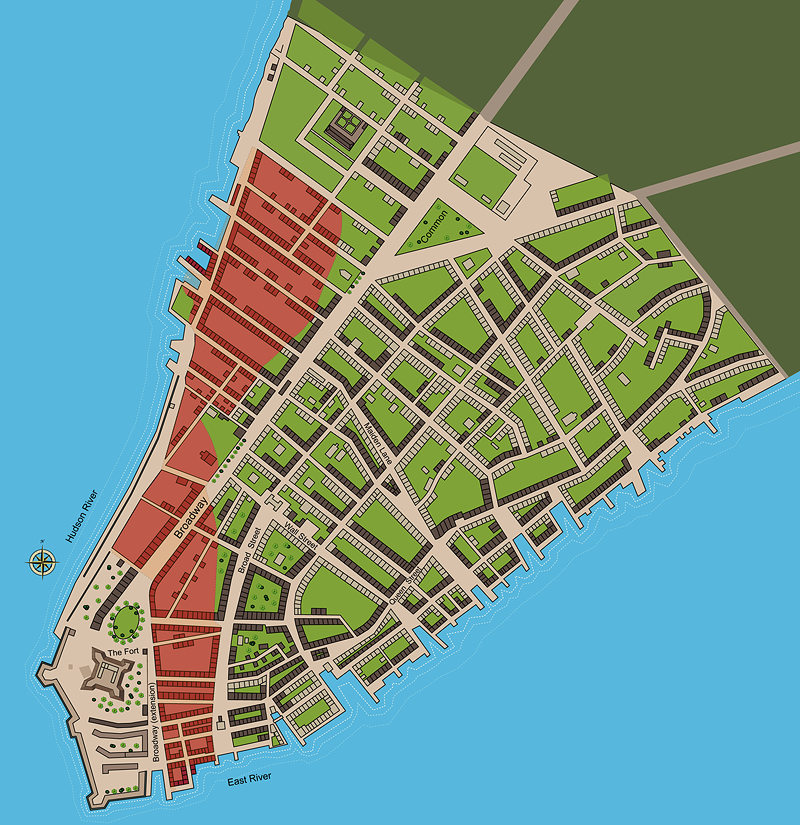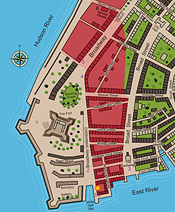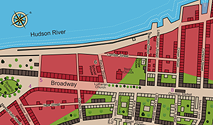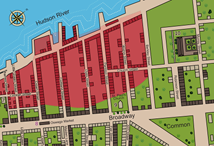Appendix #23: The Fire of 1776 (Click on small maps to expand)
Map of the New-York Fire of 1776 (Midnight - 2AM)
September 21, 1776
See Text for reports of arson.
Fire begins near White Hall Slip. It burns north between Broad and Broadway Streets crossing Dock Street, then Bridge, Stone and Marketfield Streets to Beaver.
Map of the New-York Fire of 1776 (After 2AM)
Note: Reports of fires set in this area before major fire reaches it are discussed in Chapter 12.
The fire burns the Lutheran Church, School House, and Trinity Church. Courtlandt's Sugar House is saved. Above Garden Street buildings on both sides of New Street do not burn. The fire is also stopped on the east side of Broadway a few houses north of Garden.
Map of the New-York Fire of 1776 (At termination)
The Fire is under control by 10AM and quenched by noon. Combustables found throughout city.
The fire never reaches Wall Street but burns north on Lumber Street through Thames, Little Queen, and Courtland Streets. The firemen still left in the city apply their engines to save the upper west side of Broadway, the Oswego market, and St. Paul's Church. The fire stops at the open ground in front of the college.
The Extent of the Great Fire of New York in 1776
This map and maps above are based on illustrations and information from the David Grim Map presented to the New York Historical Society depicting the extent of the 1776 fire. Grim included few street names, which were added here from the 1767 Map by Ratzer shown in Appendix #17 and the Maerschalck Map of 1755. Grim had updated Ratzer’s earlier depiction of the Whitehall Dock, but may not have updated Cruger’s Wharf area as discussed in Illustration and Appendix #27 below.

Illustration 23: The Fire of 1776
- Hugh Gaine, New-York Gazette and the Weekly Mercury; Monday, September 30, 1776. Gaine was the publisher, who was still publishing another paper in New Jersey with a more "pro-patriot" flavor. The article, according to Shelton, was attributed in London newspapers to "Major Rook" lately an aide-de-camp to General Gage and contributor to the "Massachusetts Gazette."
- Peter Force, American Archives: Fifth Series (Washington DC: M. St. Clair Clarke and Peter Force, 1851) Vol ii
- P461 EXTRACT FROM A JOURNAL KEPT BY THE CHAPLAIN OF COLONEL
DURKEE'S REGIMENT. (Twentieth Continental Regiment), "and had not the wind as it veered to the west, died away, the remainder of that nest of vipers would have been destroyed."
- P462 Newspaper Newark, September 28, 1776.
...The cause of the fire is not known. We imagine a sixth part of the whole city is destroyed, and many families have lost their all.
- P462-463 SIR WILLIAM HOWE TO LORD GEORGE GERMAIN. York-Island, September 23, 1776. My Lord: Between the 20th and 21st instant, at midnight, a most horrid attempt was made by a number of wretches to burn the town o{ New- York, in which they succeeded too well, having set it on fire in several places with matches and combustibles…The strictest search is making after these incendiaries...
- P463 EXTRACT of A LETTER FROM NEW-YORK TO A GENTLEMAN
IN LONDON, DATED SEPTEMHER '23, 1776.
... There were few citizens in town ; the fire-engines and pumps were out of order. Two regiments of soldiers were immediately ordered into town, and many boats full of men were sent from the fleet. ... Our distresses were great before, but this calamity has increased them ten-fold. Thousands are hereby reduced to beggary. This scheme was executed to prevent the King's troops from having any benefit by the city.
- P493-494 GOVERNOUR TRYON TO LORD GEORGE GERMAIN.
New-York, September 24, 1776….Many circumstances lead to conjecture that Mr. Washington was privy to this villainous act, as he sent all the bells of the churches out of town, under pretence of casting them into cannon; whereas, it is much more probable to prevent the alarm being given by ringing of the bells before the fire should get ahead beyond the reach of engines and buckets; besides, some officers of his army were found concealed in the city, supposed for this devilish purpose...
- P 503 JOHN SLOSS HOBART TO NEW-YORK CONVENTION.
Camp at King's Bridge, September 25, 1776.
... The most rational conjecture we can make for the cause of the fire is, that the army (British), having been promised the plunder of the town in case of conquest, and finding from their late repulse that such an event is rather too far distant for their impatience, have set fire to the town in order to facilitate their views.
- P524 EXTRACT OF A LETTER FROM AN OFFICER AT HARLEM, Dated September 25, 1776. By the best accounts, we learn, that about a quarter part of the city of York is burnt, and that it was purposely fired by some private persons. …The Hessians are continually plundering, and are countenanced by their General; and General Howe dares not punish them for fear of producing a general mutiny.
- P820 COMMITTEE OF SECRET CORRESPONDENCE TO SILAS DEANE.
Philadelphia, October 1, 1776....Since then the city of New-York has been on fire, and it's said one-fifth or one-sixth of it is reduced to ashes. The enemy charged some stragglers of our people that happened to be in New-York with having set the city on fire designedly… They will no doubt endeavour to throw the odium of such a measure on us; but in this they will fail, for General Washington... desired to know the sense of Congress respecting the destruction of the city…but Congress resolved that it should be evacuated and left unhurt, as they had no doubt of being able to take it back at a future day. - Carleton Commission Report: From the Manuscript of Proceedings of the Board of Enquiry as authorized by General Carleton in 1783at the New-York Historical Society (New York City: Misc MSS Boxes 12 & 13 1776-1780). 39 testimonies. See Appendix #23A/B
- Edward G. Burrows and Mike Wallace, Gotham: A History of New York City to 1898 (Oxford University Press: Oxford, New York et al 1999), "the flight of thousands of Tories" (% leaving) p227; figures for American and British armies. Pages 229, 234, p245
- Henry, John Joseph Campaign Against Quebec (Knowlton and Rice, Watertown, N.Y., 1844) pages 200-202 for objective American witness to fire and its progress.
- Thomas Jones, The History of New York during the Revolutionary War (NEW YORK: PRINTED FOR THE NEW YORK HISTORICAL SOCIETY. 1879) With Notes, Contemporary Documents, Maps, and Portraits EDITED BY EDWARD FLOYD de LANCEY, Volume 1: page 617 quoting Inglis for the estimate of £25,000 sterling. That today would be £3 million ($5 million) with a “CPI-type’ measure. P611 Howe letter as in American Archive above. P612 Washington reply: : "Gentlemen, I am favored with yours of the 22d, acquainting me with a report now circulating, ' that if the American army should be obliged to retreat from this city, any individual may set it on fire.' " I can assure you, gentlemen, this report is not founded on the least authority from me ; P615 Letter to Tryon to Germain …some officers of his army were found concealed in the city, supposed for this devilish purpose. The town was thought to be saved more by a sudden change in the wind (which blew strong) and by pulling down intermediate houses, than by water. The fire broke out in sundry places nearly at the same time, but was first discovered at Whitehall stairs."
- Shelton, William Henry (p47) noted that Force's American Archive had deleted stories of arsonists being caught red-handed.
- Diary of Frederick Mackenzie: Giving a Daily Narrative of His Military Service as an Officer ofthe Regiment of Royal Welch Fusiliers during the Years 1775–1781 (Cambridge: Harvard University Press, 1930), 2:58 See Mackenzie's Table of Guards.
- Carp, Benjamin L. The Night the Yankees Burned Broadway (Early American Studies (Fall 2006)) The McNeil Center for Early American Studies. Pages 472-511 Note extensive references on many major points. The Hessian Adjutant General Major Carl Baurmeister guessed that 560 buildings had burned and Mackenzie guessed 600, whereas the merchant David Grim later calculated 493 buildings had burned. Observers estimated that between a sixth and a quarter of the city had been reduced to ashes... The British armed forces could have bombarded and destroyed the city any time they liked—just as they had set fire to Charlestown, Massachusetts, Falmouth, Maine, and Jamestown, Rhode Island...
- Frank E. Grizzard Jr. and David R. Hoth, eds., The Papers of George Washington: Revolutionary War Series (Charlottesville: University Press of Virginia,2002) (PGW:RS), The Papers of George Washington Digital Edition. Revolutionary War Series (16 June 1775–31 December 1783, Volume 8 (6 January 1777–27 March 1777) January 12, 1777. Trumball to Washington https://rotunda.upress.virginia.edu/founders/GEWN-03-08-02-0058
- Thomas Jones, The History of New York during the Revolutionary War (NEW YORK: PRINTED FOR THE NEW YORK HISTORICAL SOCIETY. 1879) With Notes, Contemporary Documents, Maps, and Portraits EDITED BY EDWARD FLOYD de LANCEY. Has comprehensive list of Loyalists from which to identify witnesses in Carleton Commission.
- HENRY P. JOHNSTON, THE CAMPAIGN OF 1776 AROUND NEW YORK AND BROOKLYN (BROOKLYN, N.Y.: THE LONG ISLAND HISTORICAL SOCIETY, 1878). DIARY OF REV. MR. SHEWKIRK, PASTOR OF THE MORAVIAN CHURCH, NEW YORK [240]... The fire was then in the lower part of Broad street, Stone street, &c. It spread so violently that all what was done was but of little effect; if one was in one street and looked about, it broke out already again in another street above; and thus it raged all the night, and till about noon. The wind was pretty high from south-east, and drove the flames to the northwest. It broke out about White Hall; destroyed a part of Broad street, Stone street, Beaver street, the Broadway, and then the streets going to the North River, and all along the North river as far as the King's College...
- Frank Moore, Diary of the American Revolution (New York: Charles Scribner, 1860) P311 – 314 Clift's Diary general account of fire. Footnote on Page 313 another account by David ‘Grin’in Barber’s New York Freeman’s Journal January 7, 1777.
- From George Washington to Lund Washington, 6 October 1776,” Founders Online, National Archives, last modified April 12, 2018, https://founders.archives.gov/documents/Washington/03-06-02-0379. [Original source: The Papers of George Washington, Revolutionary War Series, vol. 6, 13 August 1776 – 20 October 1776, ed. Philander D. Chase and Frank E. Grizzard, Jr. Charlottesville: University Press of Virginia, 1994, pp. 493–495.] In this letter Washington expressed he really did want to burn the city, but was restrained by Congress. "Had I been left to the dictates of my own judgment, New York should have been laid in Ashes before I quitted it—to this end I applied to Congress, but was absolutely forbid."
- I.N. Phelps Stokes, Iconography of Manhattan Island Vol 5.(New York: Robert Dodd 1926) page 1020 Kemble's Journal 89-90 The Wind blowing hard a South East. The fire was first discovered between 12 & 1 o'Clock in that block of Houses fronting Mr. Watts's and near the Exchange, in a House facing the Water; from thence It ranged up the Broadway and Broad Street" Loyalist Letter transcribed Many of the Villains were apprehended, with Matches in their-Hrnds [sic] to set Fire to the Houses. A Fellow was seized, just about to set Fire to the College, who acknowledged he was employed for the Purpose. A New England Captain was seized, with Matches in his Pocket, who acknowledged the same... " Mr. Shelton, in The Jumel Mansion, 47 and 64, calls attention to the tact that the portion of this account referring to "A New England Captain" was omitted from the transcription in the 5 Amercian Archive vol., II: 463.
P 1021 Excerpt written by David Grim for the N. Y. Hist. Soc: "This fire of 1776 commenced in a small wooden house, on the wharf near the White Hall Slip, it was then occupied by a number of men and women of a bad character; ... There being very few inhabitants in the city, in a short time it raged tremendously…. "The number ot Houses, that were burned and destroyed, in the city at that awful conflagration were thus; viz' "From Mortkill Street to Courtlandt St. 167 "Courtlandt Street to Beaver St. 175 "Beaver Street to E. river, 151 Houses 493 There being very few inhabitants in the city at that time, and many of those were afraid to venture at night in the streets, fearing of being taken up as suspicious persons.
P1022 Rev. Charles Inglis in Letter to S.P.G.F.P. "Several rebels secreted themselves In the houses, to execute the diabolical purpose of destroying the city. On the Saturday following an opportunity presented itself; for the weather being very dry, and the wind blowing fresh, they set fire to the city In several places at the same time, between twelve and one o'clock in the morning. … This church (Trinity) with the Rector’s House and the charity School – the two latter, large expensive buildings,—were burned…The church corporation had suffered prodigiously, as was evidently intended. Besides the buildings already mentioned, about 200 houses, which stood on the church ground, were consumed; so that the loss cannot he estimated at less than 25,000l sterling."
P 1023 Lieut. Tench Tilghman, writing on Sept, 25 to his father, says: "Reports concerning the setting fire to New York, if it was done designedly, it was without the knowledge or Approbation of any commanding officer in the army, and indeed so much time had elapsed between our quitting the City and the fire, that it can never be fairly attributed to the Army." Memoir of Lieut. Col. Tench Tilghman (1876), 140.



